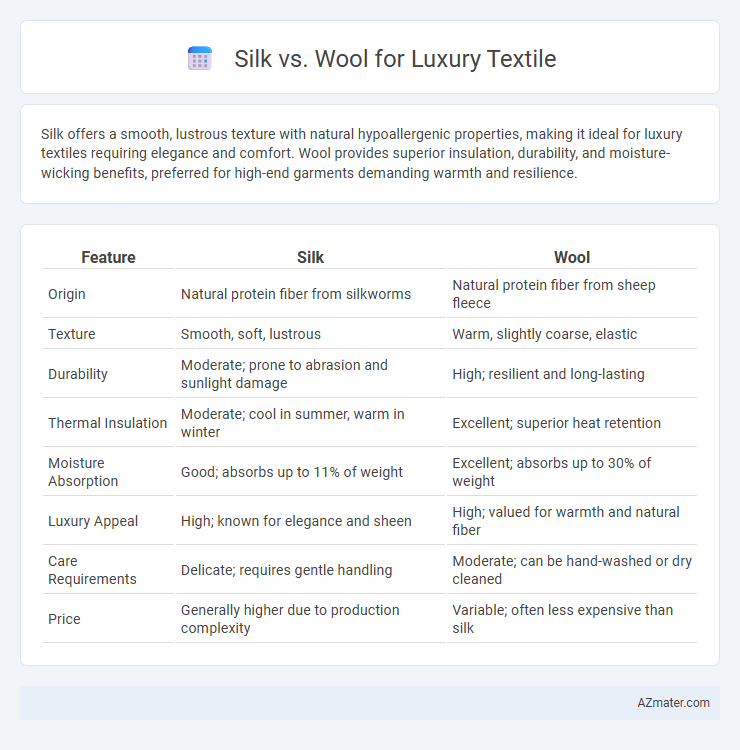Silk offers a smooth, lustrous texture with natural hypoallergenic properties, making it ideal for luxury textiles requiring elegance and comfort. Wool provides superior insulation, durability, and moisture-wicking benefits, preferred for high-end garments demanding warmth and resilience.
Table of Comparison
| Feature | Silk | Wool |
|---|---|---|
| Origin | Natural protein fiber from silkworms | Natural protein fiber from sheep fleece |
| Texture | Smooth, soft, lustrous | Warm, slightly coarse, elastic |
| Durability | Moderate; prone to abrasion and sunlight damage | High; resilient and long-lasting |
| Thermal Insulation | Moderate; cool in summer, warm in winter | Excellent; superior heat retention |
| Moisture Absorption | Good; absorbs up to 11% of weight | Excellent; absorbs up to 30% of weight |
| Luxury Appeal | High; known for elegance and sheen | High; valued for warmth and natural fiber |
| Care Requirements | Delicate; requires gentle handling | Moderate; can be hand-washed or dry cleaned |
| Price | Generally higher due to production complexity | Variable; often less expensive than silk |
Introduction to Luxury Textiles
Silk and wool stand as iconic fibers in the realm of luxury textiles, each offering distinctive tactile properties and aesthetic appeal. Silk, prized for its lustrous sheen and smooth texture, provides a lightweight, breathable fabric ideal for high-end fashion and elegant drapery. Wool, especially fine varieties like Merino or Cashmere, delivers exceptional warmth, durability, and a soft hand feel, making it a timeless choice for opulent outerwear and sophisticated knitwear.
Overview of Silk and Wool
Silk is a natural protein fiber produced by silkworms, renowned for its smooth texture, natural sheen, and exceptional strength, making it a symbol of luxury in textiles. Wool, derived from the fleece of sheep, offers superior insulation, elasticity, and moisture-wicking properties, prized for its warmth and durability in high-end fabrics. Both fibers are biodegradable and renewable, with silk favored for delicate, lightweight garments and wool ideal for structured, insulating apparel in luxury fashion.
Historical Significance of Silk and Wool
Silk, prized since ancient China's Han dynasty, symbolized wealth and status through its intricate production and trade along the Silk Road, influencing global luxury textile markets. Wool, vital to European medieval economies, powered the booming textile industry, notably in England and Italy, with its durability and warmth making it a staple of aristocratic and royal garments. Both fibers have shaped cultural identities and luxury fashion, preserving artisanal techniques that continue to define high-end textile craftsmanship today.
Production Processes: Silk vs Wool
Silk production involves sericulture, where silkworms spin cocoons that are carefully harvested and unraveled to obtain smooth, lustrous fibers requiring meticulous handling and significant labor intensity. Wool production originates from shearing sheep, with fiber blending and cleaning processes designed to preserve warmth, elasticity, and durability, emphasizing sustainable ranching practices. Both textiles demand specialized techniques, but silk's complex sericulture contrasts with wool's more straightforward animal husbandry and processing, impacting cost and availability in luxury markets.
Texture and Appearance Comparison
Silk offers a smooth, glossy texture with a natural sheen that enhances its luxurious appearance, making it ideal for elegant, lightweight garments. Wool provides a richer, warmer texture with a matte finish and more pronounced fiber structure, suited for cozy, high-quality outerwear. The choice between silk and wool hinges on the desired tactile feel and visual sophistication in luxury textiles.
Comfort and Wearability
Silk offers exceptional softness and natural temperature regulation, making it ideal for breathable, lightweight luxury textiles that feel smooth against the skin. Wool provides superior insulation and moisture-wicking properties, maintaining warmth while managing sweat, which enhances comfort during extended wear. The choice depends on desired climate adaptability and fabric weight, with silk favoring warmer, airy conditions and wool excelling in cooler, more variable environments.
Durability and Longevity
Silk offers a luxurious sheen and softness but tends to be less durable compared to wool, with vulnerability to abrasion and sunlight reducing its longevity. Wool fibers provide exceptional resilience and natural elasticity, making wool textiles highly resistant to wear and tear while maintaining shape over time. Luxury textiles crafted from wool often outlast silk counterparts due to wool's superior durability and natural moisture-wicking properties that prevent fiber degradation.
Maintenance and Care Requirements
Silk demands gentle maintenance, including hand washing with mild detergent or dry cleaning, and requires protection from prolonged sun exposure to prevent fiber damage and color fading. Wool benefits from its natural resilience, often allowing for less frequent cleaning and lower risk of shrinking when cared for properly with cool water washes and flat drying. Both fibers necessitate careful storage in breathable containers to avoid moth damage and maintain their luxurious texture and appearance.
Sustainability and Ethical Considerations
Silk production involves mulberry cultivation and delicate sericulture that demands high water use but benefits from biodegradable properties, while wool relies on sheep grazing that can lead to land degradation if unmanaged yet is renewable and biodegradable. Ethical concerns in silk include the traditional boiling of silkworms, prompting innovations like peace silk, whereas wool raises issues about animal welfare and shearing practices. Both textiles contribute to sustainable luxury when sourced responsibly through certifications like GOTS for wool and OEKO-TEX for silk, promoting eco-friendly and ethical supply chains.
Choosing Between Silk and Wool for Your Luxury Needs
Silk offers a smooth, lustrous texture ideal for lightweight luxury apparel and accessories, renowned for its natural sheen and breathability. Wool provides exceptional warmth, durability, and moisture-wicking properties, making it a preferred choice for cozy, high-end winter garments. Selecting between silk and wool depends on climate, desired texture, and garment function, with silk excelling in elegance and softness, while wool ensures insulation and resilience.

Infographic: Silk vs Wool for Luxury textile
 azmater.com
azmater.com